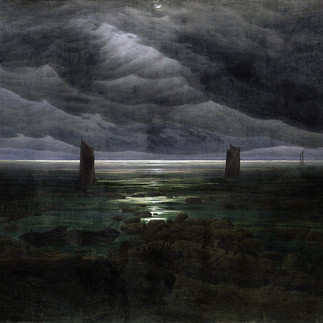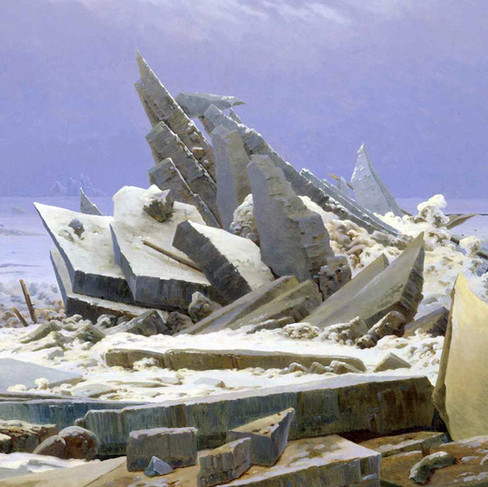
An entire land filled with Disney Villains!
If you are a Disney fan, then you were undoubtedly among the throngs of people who collectively screamed with DELIGHT when Disney announced at D23 that a Villains Land is coming to Walt Disney World's Magic Kingdom. I know I shrieked with excitement and couldn't stop bouncing up and down!
An entire themed land devoted to famous Disney villains? Yes, please!
Even if you aren't a Disney fan, maybe you will still agree that the announcement for a Villains Land is an amazing idea. It's a daring idea for any theme park, and here we have Disney drawing a line in the sand with Universal, who had already announced and started to build a Dark Universe in Orlando.
And based on what the concept art shows, it appears Disney is going to deliver something spooky, ominous, and foreboding, something intended to overwhelm you. Something that awes and terrifies us all at once.
And you know what the concept artists were clearly looking at for inspiration? Art History, of course!

Villains Land concept art and nods to art history
Disney artists, animators, and Imagineers frequently look to art and architecture from around the world for inspiration. I wouldn't be writing this blog nor writing a book series about Disneyland art history if they didn't! I muse about all of this here and spend too much time on socials looking at all this fun art history at Disney.
For the new Villains Land concept images, artists seem to be looking at Romantic landscape imagery—and most notably the 19th-century German artist Caspar David Friedrich.

Caspar David Friedrich and Disney Art History
As soon as I saw the concept art for Villains Land, I thought of Caspar David Friedrich's landscape paintings. I see clear adaptations or inspirations in the new Magic Kingdom land. And it makes sense to me, given Disney artists' use of famous art and architecture and specifically Friedrich's enduring influences.

Friedrich was one of the artists in the 19th century who helped to elevate the status of landscape painting. Prior to that era, landscape painting across Europe generally wasn't viewed as important as other genres like history paintings. There was an entire hierarchy of art, and artists in different moments pushed back against it and the limitations and boundaries imposed on them. Artists associated with Romanticism wanted to change that. Friedrich and others of his era were among those who helped to move that needle. Romantic painters focused on capturing landscapes felt that they could move people and inspire ideas, just like other genres could (looking at you, history painting).

Friedrich himself believed that nature was awesome. And by awesome, I don't just mean cool or neat. I mean that he felt nature was awe-inspiring, humbling, sublime, overwhelming, ethereal, beautiful; in short, awesome. People could become one with nature, enveloped by it.
And Friedrich, like others, found ways to capture in paint these feelings and ideas. He would study nature outside, often sketching the land, and then paint in his studio.
In his paintings, he often shows humans overwhelmed by the sublime, by the awesomeness of nature. This means that in paintings like Uttewalder Grund you might see tiny figures amidst the land that you might overlook.

He was also into creating moody scenes, which he produced using dark blues and purples. The man also loved mist and large banks of clouds and twisting, gnarled trees, and even jagged mountains rising up in the distance.
The Disney concept art for Villains Land uses many of the same forms, colors, and techniques to create its own mysterious, spooky, ominous land. There are jagged mountains in the background, the same dark and ominous, yet ethereal light, dark purples and blues, moody clouds. It's misty and expansive. It's overwhelming and awesome. But what REALLY convinced me of Friedrich's influence on the Disney concept artists is what I see in the foreground around that turquoise pool of water.

Friedrich's The Sea of Ice
Friedrich's painting The Sea of Ice (1823–24, once know as The Polar Sea) is, in my opinion, the clearest influence on the Disney concept art for Villains Land. The Romantic painting shows a sinking ship in the Arctic surrounded by an icebergs that are breaking up into what appear like sharp, jagged pieces of glass—or in this case, ice. The icebergs are stacked atop one another, rising upwards in sharp movements. The way Friedrich paints them it almost looks like a villainous abode made of ice. Instead of showing the landscape towering over tiny human figures, he includes the sinking ship as the ice and water engulf it forever more. Looking at it, we are supposed to be awed by the power of nature and be scared of that awesomeness.
Villains Land concept art and art history
Now, let's look again at the Villains Land concept art. You see the influence of Friedrich too now, right? Those rocks in the foreground rise and pierce the air just like Friedrich's broken ice. That same feeling of awe and dread are clear in both.
So there you have it folks. My initial art historian opinion of the new concept art for Villains Land. What do you think? Do you see the connections between the Villains Land concept art and nods to art history?
If you enjoy all this Disney and art history insight and fun, please sign up for my newsletter.
Learn more!
Online exhibition at Europeana about The inspiration of nature Arcadian and romantic landscapes.
An essay about Romanticism from The Metropolitan Museum's Heilbrunn Timeline.
More about Villains Land from WDW Magic.














Comments